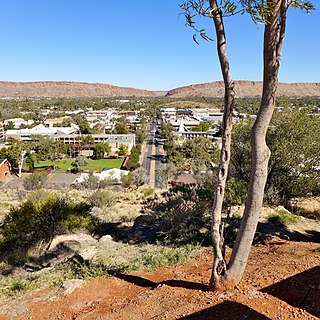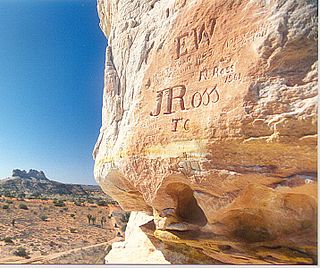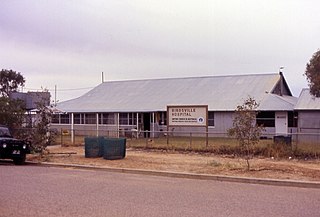
Alice Springs is the third-largest town in the Northern Territory of Australia. Known as Stuart until 31 August 1933, the name Alice Springs was given by surveyor William Whitfield Mills after Alice, Lady Todd, wife of the telegraph pioneer Sir Charles Todd. Known colloquially as 'The Alice' or simply 'Alice', the town is situated roughly in Australia's geographic centre. It is nearly equidistant from Adelaide and Darwin.

The Royal Flying Doctor Service of Australia is an air medical service in Australia. It is a non-profit organisation that provides emergency and primary health care services for those living in rural, remote and regional areas of Australia who cannot access a hospital or general practice due to the vast distances of the outback. It is one of the largest and most comprehensive aeromedical organisations in the world.

John Flynn was an Australian Presbyterian minister who founded the Australian Inland Mission (AIM) which later separated into Frontier Services and the Presbyterian Inland Mission, as well as founding what became the Royal Flying Doctor Service, the world's first air ambulance.

The Australian Presbyterian Mission was founded by the Presbyterian Church of Australia to reach those "beyond the farthest fence" with God's Word. It is better known as the Australian Inland Mission (AIM). Rev. John Flynn was the first superintendent possessing a vision and dedication to see that "hospital and nursing facilities are provided within a hundred miles of every spot in Australia where women and children reside".

Lake Grace is a town in the eastern Wheatbelt region of Western Australia, 345 kilometres (214 mi) from Perth along State Route 107 between Wagin and Ravensthorpe. It is the main town in the Shire of Lake Grace. At the 2016 census, Lake Grace had a population of 507.

Chambers Pillar is a sandstone formation some 160 km (100 mi) south of Alice Springs in the Northern Territory of Australia.

Beltana is a town 540 kilometres (336 mi) north of Adelaide, South Australia. Beltana is known for continuing to exist long after the reasons for its existence had ceased. The town's history began in the 1870s with the advent of copper mining in the area, construction of the Australian Overland Telegraph Line and The Ghan railway and began to decline in 1941 with the beginning of coal mining at Leigh Creek. The fortune of the town was sealed by the 1983 realignment of the main road away from the town. The town, adjacent cemetery and railway structures are now part of a designated State Heritage Area declared in 1987.
Point Pearce, also spelt Point Pierce in the past, is a town in the Australian state of South Australia. The town is located in the Yorke Peninsula Council local government area, 194 kilometres (121 mi) north-west of the state capital, Adelaide. At the 2016 census, Point Pearce had a population of 91.

Australian Inland Mission Hospital is a heritage-listed former hospital at Adelaide Street, Birdsville, Shire of Diamantina, Queensland, Australia. It was built from 1952 to 1953 by Ben Hargreaves. It was added to the Queensland Heritage Register on 17 July 2008.

Royal Hotel is a heritage-listed former hotel, former hospital and now ruin at Adelaide Street, Birdsville, Shire of Diamantina, Queensland, Australia. It was built c. 1883. It was later known as Australian Inland Mission Hospital, AIM Hostel, and Birdsville Nursing Home. It was added to the Queensland Heritage Register on 21 October 1992.
Alec Donald Ross OAM was an Australian tour guide, member of the stolen generation and custodian of the story of the Alice Springs Telegraph Station in the Northern Territory of Australia.
Percy McDonald Smith (1903-1982) was the first Priest-in-Charge of Alice Springs for the Anglican Church. He was also the first Archdeacon of the Northern Territory, Australia, founder of St John's Hostel in Alice Springs and later the founder of St Francis House in the Adelaide suburb of Semaphore South at Glanville Hall.

The Stuart Arms Hotel was the first hotel in Alice Springs, Northern Territory. Located on the corner of Parsons and Todd Street, it was centre of social life for 96 years.
Stuart Town Gaol in Alice Springs, Northern Territory, Australia, located on 9 Parson Street, was constructed in 1907, when Alice Springs had a European population of approximately 30 people, and held its first prisoner in 1909. It is one of the earliest permanent buildings constructed in the town and the first government building. The gaol follows a simple design and was built, using local materials, by stonemason Jack Williams.

The Todd Mall is a mostly pedestrian mall in Alice Springs in the Northern Territory of Australia which serves as its "main street" and is one of the primary locations for shopping and leisure in the town. It contains many of the town's restaurants.
St. Mary's Hostel, formerly Mount Blatherskite Hostel (1946–47), commonly known simply as St Mary's, was an Australian Board of Missions hostel in Alice Springs from 1947 to 1972. Its residents were mostly Aboriginal children, including some who were taken as wards of the state because they were half-caste. In 1972, coming under new management, it was renamed St Mary's Children's Village (1972–1980).
Griffiths House was a Methodist children's home and hostel that operated in Alice Springs, in the Northern Territory of Australia, from 1945 - 1965. It was for children from remote areas of Central Australia who were attending school in Alice Springs.
Little Flower Mission operated from 1938 to 1942 and it was a mission to Eastern Arrernte people who were living in and around the township of Alice Springs. The mission was established by Catholic missionaries, part of the Missionaries of the Sacred Heart order.
Harry Griffiths was a Reverend who worked for the Methodist Inland Mission in Alice Springs; Northern Territory and is best remembered for establishing Griffiths House as well as designing and opening the ANZAC Hill memorial.
Australian Indigenous Ministries, formerly Aborigines Inland Mission of Australia, is an interdenominational Christian organisation that provides ministries to Aboriginal Australians. Aborigines Inland Mission of Australia was established in 1905, and ran many Aboriginal missions across Australia, including the Retta Dixon Home in Darwin, Northern Territory, St Clair Mission in Singleton, New South Wales.











